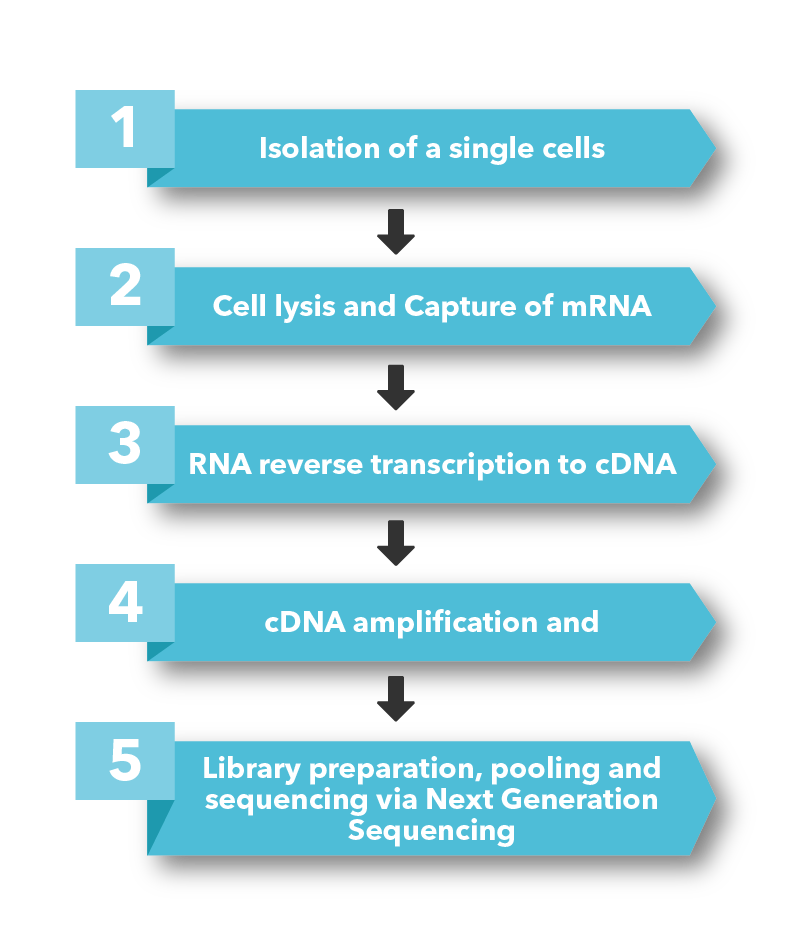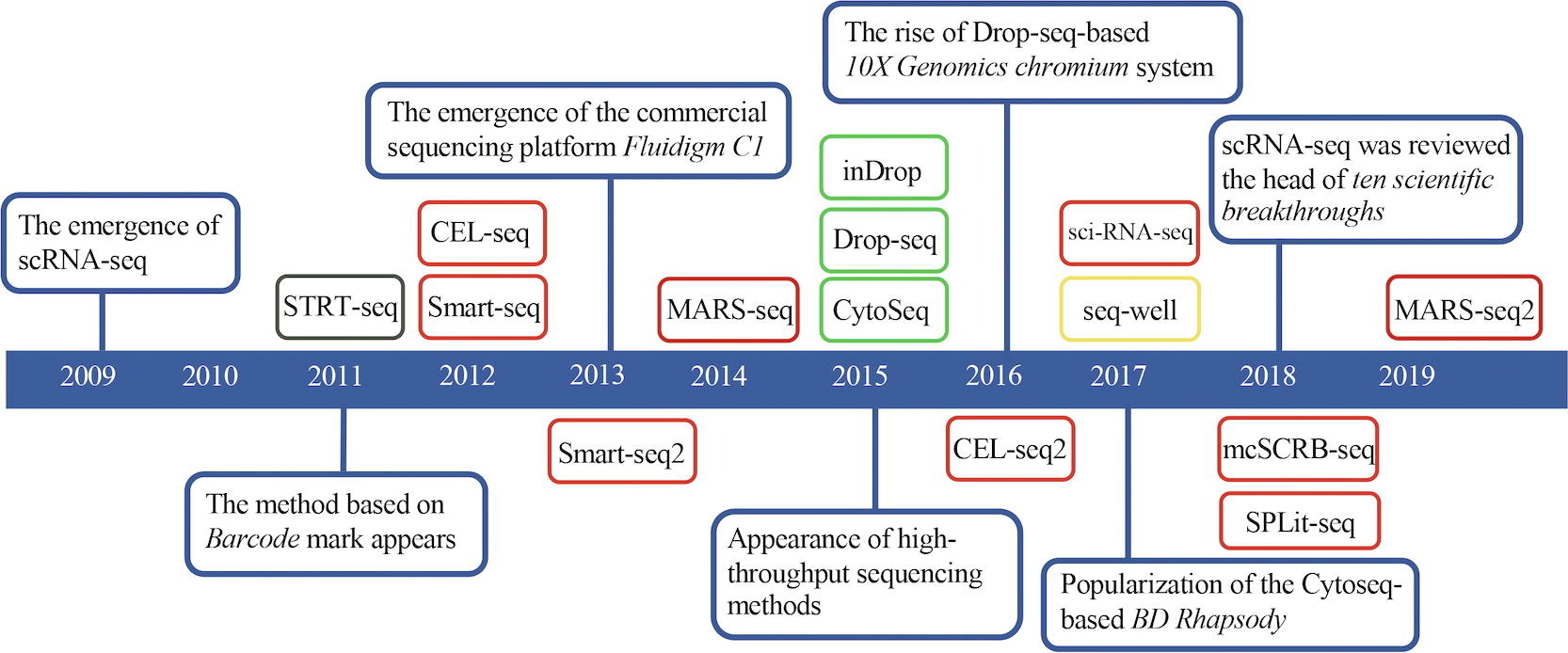By Vinay CG, Derek Vargas and Neha Varma, MedGenome Scientific Affairs
Next-generation sequencing techniques has seen an unimaginable growth in the past two decades. The scope has really broadened, and it is now possible to look at a genome both at macro and micro levels. Single-Cell RNA sequencing (scRNA-seq) is one such technique which deals with understanding the transcriptome at a cellular level. Single cell RNA sequencing can provide unparalleled insights into the various cellular events. scRNA-seq has an advantage over the bulk RNA-seq studies since it provides higher resolution in terms of cell subsets diversity and individual cell heterogeneity in the organisms.
There are many scRNA-seq techniques available [1], – widely used Smart-seq2, MARS-seq, 10X Genomics, BD Rhapsody, sci-RNA-seq, in-drop and Seq-well (Figure 1) – however, all of them follow a similar approach i.e.


Source: https://doi.org/10.1016/j.csbj.2020.10.016
Even though scRNA-seq has several challenges one such being the high cell-to-cell variability owing to both technical and biological noise (gene expression, cellular states, cell sizes and cell cycle state) [2] – it is still an effective technique in revealing complex cellular events that can aid medical research. Now, researchers can obtain a multi-omics profiling involving genome, epigenome and transcriptome or protein information from the same single cell.
Due to its ability to provide a deeper understanding into the nature of immune cells scRNA-seq techniques can be used for:
- 1. Profiling the immune response to pathogens/infections
- 2. Evaluation of vaccines
- 3. Tailor personalized cancer vaccines
- 4. Interrogate pathogen and host transcriptomes
- 5. BCR analyses for mAB Development
Profiling the immune response to pathogens/infections
With scRNA-seq it is now possible to understand the molecular details of host-pathogen interaction in greater detail. Understanding the inflammatory factors triggered by immune cells in response to pathogen invasion can be useful in knowing the disease pathogenesis [3]. Few of the useful insights could be in the areas of inflammatory response analysis, identifying differently expressed genes during infection, knowing susceptible cell types, analysing infection dynamics, and studying immune repertoire [3].
Evaluation of Vaccines
scRNA-seq can be used to compare vaccine regimens and responses. Immunogenicity to vaccine is determined by several factors such as vaccine antigen, vaccine platform and adjuvant. scRNA-seq can be very useful in measuring these factors in a more specific and efficient way [1]. Besides, curating and characterizing single cell datasets of known types of pathogens at various stages of infection can help in identifying right vaccine targets [1]. scRNA-seq captures crucial information about cell types susceptible to the infection which will help the development of strategies for intervention. It can also aid in antigenic screening and selection by providing a clear insight into the immune response generated by vaccines with different antigenic makeups.
Tailor Personalised Cancer Vaccines
scRNA-seq can be extensively used in neoepitope selection and vaccine workflows. The parameters such as growth inhibition, antibody selection, cytokine secretion and a comprehensive analysis of scRNA datasets can provide deeper insights into vaccine responses. Especially, with anti-cancer drugs used to target tumor cells, some of the cells will develop resistance to such drugs. scRNA can be used to provide information on these cellular subsets that could be responsible for tumor recurrence, mutations, and pathways that can be responsible for driving tumor growth [4]. The detailed immune cell maps of multiple immunophenotypes in tumor microenvironment have been drawn via this novel sequencing method, which has deepened our understanding of tumor cell heterogeneity. These insights can be useful in identifying novel biomarkers, develop better immune responses and tailor personalized vaccines.
Interrogate pathogen and host transcriptomes
Studying the host-pathogen interaction after their encounter can provide invaluable insights into the outcomes. The scRNA-seq can help us understand which host cell types infected and which ones are able to respond to pathogens [5]. Paired dual scRNA-seq is emerging as a novel technique in understanding of those molecular pathways that would help for the host to have a distinct advantage over the pathogen. One more advantage scRNA-seq provides over the bulk studies is the high resolution it provides in identifying potential signals in rare cell populations during an infection which can help in predicting better pathogenic response, understand disease states and to identify correct biomarkers.
BCR analyses for Mab Development
scRNA-seq can provide valuable insights into full-length heavy and light chain sequences in B cells. Somatic hypermutation (SHM) and class switching are the key determinants for antibody diversity. Since, antibody discovery is important for early stage research studies, diagnostics and therapeutics, at MedGenome we have streamlined antibody discovery using high-throughput single B cell receptor sequencing and a recently licensed proprietary platform, HiTMab* (High-throughput monoclonal antibody discovery). HitMab uses high-throughput single-cell B-cell receptor sequencing (scBCR-seq) to obtain accurately paired full-length variable regions in a massively parallel fashion. Our scBCR-seq not restricted only to mice and humans but also extended to custom species including horse and rat.
Want to know more about our exciting Single-cell RNA sequencing (scRNA-seq) Solutions?
Get in touch with our experienced and seasoned scientific team to understand how our unique single-cell RNA sequencing (scRNA-seq) solutions can provide deeper insights to your research projects. You can also email us at research@medgenome.com for any queries and further details.
References
- 1. The Application of Single-Cell RNA Sequencing in Vaccinology, Journal of Immunology Research, Volume 2020, Article ID 8624963
- 2. Hedlund E, Deng Q, Single-cell RNA sequencing: Technical advancements and biological applications, Molecular Aspects of Medicine (2017), http://dx.doi.org/10.1016/j.mam.2017.07.003
- 3. Geyang Luo, Qian Gao, Shuye Zhang, Bo Yan: Probing infectious disease by single-cell RNA sequencing: Progresses and perspectives, Computational and Structural Biotechnology Journal, Volume 18, 2020, Pages 2962-2971, ISSN 2001-0370, https://doi.org/10.1016/j.csbj.2020.10.016.
- 4. Li L., Xiong F., Wang, Y. et al. What are the applications of single-cell RNA sequencing in cancer research: a systematic review. J Exp Clin Cancer Res 40, 163 (2021). https://doi.org/10.1186/s13046-021-01955-1
- 5. Penaranda C, Hung DT. Single-Cell RNA Sequencing to Understand Host-Pathogen Interactions. ACS Infect Dis. 2019 Mar 8;5(3):336-344. doi: 10.1021/acsinfecdis.8b00369. Epub 2019 Jan 31. PMID: 30702856.
#Single-cell RNA sequencing, #RNA sequencing, #BCR analyses, #monoclonal antibody, #cancer vaccines, #tumor, #cancer, #HitMAB, #scBCR-seq
 US
US IN
IN

